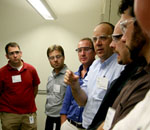Exposure Research
EPA's exposure science leads to improved methods, measurements and models to assess and predict exposures of humans and ecosystems to harmful environmental stressors. Environmental stressors can include chemical pollutants, microbes and pathogens, physical agents such as land use, and processes such as alteration of wildlife habitat.
Exposure science also provides the foundation for the development of approaches to reduce these exposures, and safeguard human health and the environment.
Tools and Technology |
|
News and Publications |
Get Involved |
Exposure Research News
Scientists evaluate air sensors developed during EPA’s Air Sensor Evaluation and Collaboration Event
On September 11 and 12, app and sensor developers from across the U.S. and select European countries gathered at the EPA’s Research Triangle Park (RTP) facility for initial discussions on laboratory evaluations of their air monitoring devices.
Read more about the air sensor evaluation event...
National Research Council releases report on Exposure Science in the 21st Century commissioned by EPA and NIEHS
Recognizing that exposure science is a key component for providing the best public health and ecosystem protection, EPA has taken several steps to ensure that the science and research that informs Agency decisions keeps pace with current and emerging environmental issues.
Read more about the NRC's report on exposure science...
New Testing Methods for Arsenic and Lead in Soil
EPA scientist Karen Bradham, Ph.D., and her research partners are working on inexpensive methods for assessing arsenic levels as a means to improve human exposure estimates for soil arsenic and lead.
Read more about EPA’s new testing methods for arsenic in Science Matters...
EPA Releases Latest Community Multiscale Air Quality Model
This fall, EPA scientists released a new version of its groundbreaking Community Multiscale Air Quality modeling system. Earlier versions of this state-of-the-science modeling system (known as "CMAQ") have been used by EPA and states for more than a decade to design emission control strategies needed to meet and maintain national air quality standards.(April 26, 2012)
Read more about CMAQ in Science Matters...
New EPA report details data sources for studying older adults’ environmental exposures
A new report developed by EPA exposure scientists, "Data Sources Available for Modeling Environmental Exposures in Older Adults," provides a detailed overview of existing sources of information for studying and modeling seniors' exposures to potentially hazardous chemicals and other pollutants. The report also provides a "state of the science" snapshot as of the end of 2009.
Top Questions
Related Links
Featured Resources
Annual CMAS conference
brings together air
quality modelers from
around the world
The 2012 Community Modeling and Analysis Systems (CMAS) Conference will be held Oct. 15-17 at the University of North Carolina at Chapel Hill. This annual conference brings together air quality modeling scientists from around the world and provides a venue for sharing best practices and new ideas for air quality modeling science. To support the CMAQ user community, EPA and UNC-Chapel Hill host the
CMAS Center, which coordinates
the annual conference.









